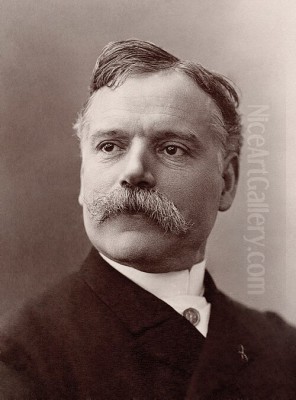
Jules Chéret stands as a pivotal figure in the history of graphic arts, widely celebrated as the "Father of the Modern Poster." Spanning a prolific career from the mid-19th century into the early 20th century (1836-1932), Chéret revolutionized the medium of the poster, transforming it from simple text-based announcements into vibrant, captivating works of art that defined the visual landscape of Belle Époque Paris and laid the groundwork for modern advertising and graphic design. His innovations in color lithography, his dynamic compositions, and his iconic portrayal of joyful women created a new visual language that captivated the public and influenced generations of artists.
Early Life and Artistic Awakening
Jules Chéret was born in Paris, France, on May 31, 1836, into a family of artisans. While described as poor, the household environment was nonetheless creative. Financial constraints, however, meant that Chéret's formal education concluded prematurely at the young age of thirteen. This marked the beginning of his practical immersion into the world of graphic arts, as he embarked on a three-year apprenticeship with a local lithographer. This early training provided him with the foundational skills that would underpin his future innovations.
Despite the end of his conventional schooling, Chéret's artistic education continued through self-study and observation. In Paris, he frequented museums and galleries, drawing inspiration from the masters of the past. He was particularly captivated by the lightheartedness and painterly qualities of Rococo artists like Jean-Antoine Watteau and Jean-Baptiste-Siméon Chardin. Their influence can be discerned in the grace, movement, and often cheerful atmosphere that would later characterize his own work. Seeking to further hone his craft, Chéret also spent time studying drawing at the prestigious École Nationale de Dessin (the future École Nationale des Arts Décoratifs).
London Interlude and Technical Development
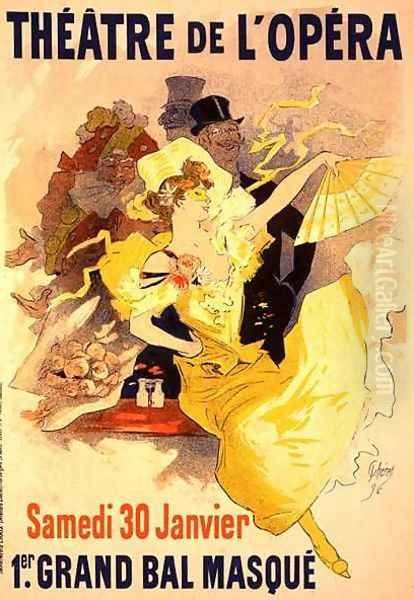
Seeking broader experience and technical knowledge, Chéret traveled to London. This period proved formative, as he immersed himself in the more advanced techniques of lithographic printing being developed and utilized in Britain. The British approach to poster design and printing methods significantly impacted his understanding of the medium's potential. During his time in London, he gained practical experience, designing book covers and posters, including early commissions for businesses like the perfume company Rimmel, whose owner, Eugène Rimmel, would become a significant patron.
This London sojourn was not continuous; Chéret moved back and forth between Paris and London, struggling to establish himself. However, the exposure to British printing technology, particularly advancements in color lithography, was crucial. He absorbed techniques that allowed for larger formats and more efficient color printing than was common in France at the time. This technical knowledge, combined with his artistic sensibilities honed in Paris, set the stage for his triumphant return and subsequent revolutionizing of the French poster scene.
Return to Paris and the Birth of the Modern Poster
Armed with enhanced technical skills and a maturing artistic vision, Chéret returned definitively to Paris around 1866. He established his own printing workshop, which gave him the freedom to experiment and control the entire creative process, from design to final print. This was a critical step, allowing him to implement the color lithography techniques he had refined. He developed a streamlined process, often using just three primary color stones (typically red, yellow, blue) plus a black stone for outlines and text. By skillfully overlapping these transparent inks, he could achieve a remarkable spectrum of vibrant hues and subtle tonal variations.
His breakthrough came quickly. Commissions for posters advertising performances at Parisian theatres, cabarets, and music halls began to pour in. Venues like the Eldorado, the Olympia, the Folies Bergère, and the Moulin Rouge became showcases for his electrifying designs. These posters were unlike anything Parisians had seen before – large, colorful, and bursting with energy, they transformed the city's walls into open-air art galleries. Chéret rapidly became a dominant force in the burgeoning world of advertising.
The Chéret Style: Color, Movement, and the "Chérette"
Chéret's artistic style was instantly recognizable and highly influential. Central to its appeal was his masterful use of color. He employed bright, luminous palettes, often featuring bold contrasts and soft, atmospheric light and shadow effects. Yellows and pinks frequently appeared, contributing to a sense of warmth, joy, and festivity that perfectly captured the exuberant spirit of the Belle Époque. His compositions were characterized by dynamic movement, swirling lines, and figures caught in moments of dance, celebration, or playful interaction.
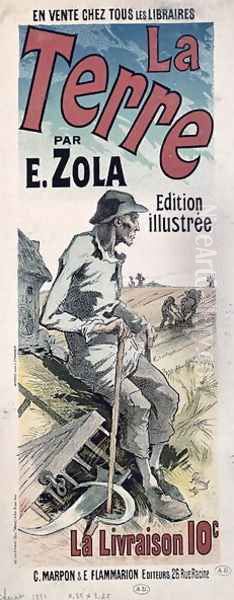
This dynamism was heavily influenced by his Rococo predecessors like Watteau and Jean-Honoré Fragonard, whose depictions of fêtes galantes and lighthearted scenes resonated with Chéret's own temperament and the demands of advertising entertainment. He adapted their elegance and lightness, translating it into the modern medium of the poster. Furthermore, like many artists of his time, Chéret absorbed influences from Japanese Ukiyo-e prints, which were becoming increasingly popular in Europe. The bold outlines, flat areas of color, and asymmetrical compositions found in Japanese woodblocks can be seen echoed in his work, particularly in his figure drawing and spatial arrangements.
Perhaps Chéret's most enduring creation was the female figure type that came to be known as the "Chérette." These women, recurring throughout his posters, were depicted as liberated, joyful, and elegantly energetic. Often shown dancing, laughing, or raising a glass, they were typically dressed in fashionable, brightly colored, low-cut gowns. The "Chérette" was a stark contrast to the more demure or allegorical female figures common in academic art. She embodied the modern Parisian woman – confident, carefree, and embracing life's pleasures. These figures became synonymous with Chéret's work and symbolized the perceived freedom and gaiety of Parisian nightlife, significantly contributing to the posters' appeal and cultural resonance. They were seen as icons of a new, more liberated femininity.
Master of Lithography
Chéret's artistic success was inextricably linked to his technical mastery of lithography. He didn't just use existing techniques; he innovated. His three-stone color process was revolutionary for its time, allowing for the mass production of colorful posters far more efficiently and artistically than previous methods. The use of transparent inks was key, enabling subtle blending and a wider range of secondary and tertiary colors directly on the press, giving his work a painterly quality.
Sources also mention his innovative use of techniques like crachis (a spatter technique, possibly involving spraying wax or ink onto the stone) to create textured, sparkling effects that enhanced the sense of light and atmosphere in his prints. This technical prowess gave him complete control over the final product, ensuring his artistic vision was translated accurately and vibrantly onto paper. His workshop became a center of excellence, pushing the boundaries of what was possible in commercial printing and elevating the status of the lithographic poster.
Iconic Works and Commercial Reach

Over his long career, Chéret produced over a thousand posters. While many were ephemeral advertisements, several stand out as iconic examples of his work and the era. His early poster for the féerie La Biche au Bois (circa 1867) is often cited as a significant early success, showcasing his emerging style. The poster for Le Punch de Grassot (1890) exemplifies his mature Art Nouveau tendencies with its flowing lines and vibrant energy.
His numerous posters for the Folies Bergère are perhaps his most famous, capturing the essence of the legendary music hall. Works advertising performers like Loie Fuller, with her swirling veils rendered in dynamic lines and colors, or general posters like Théâtre de l'Opéra, became visual emblems of Parisian entertainment. These posters were characterized by their bold typography, integrated seamlessly with the imagery, and their undeniable visual impact from a distance.
Chéret's reach extended far beyond entertainment. He became the go-to artist for advertising a wide array of consumer goods. His joyful figures promoted everything from beverages (Saxoléine oil, Pippermint liqueur) and perfumes to cosmetics, pharmaceuticals, and even literary works, such as an advertisement for Émile Zola's novel La Terre. His ability to create appealing, memorable imagery made him a giant in the advertising world, demonstrating the power of visual art in commerce.
Influence and Artistic Circle
Chéret's impact on his contemporaries and subsequent artists was immense. His vibrant posters effectively created a new art form, inspiring a generation of poster designers and painters. Henri de Toulouse-Lautrec, arguably the most famous poster artist of the era, was profoundly influenced by Chéret's work, adopting the medium and focusing on Parisian nightlife, albeit with a darker, more psychologically penetrating style.
Other artists associated with the burgeoning Art Nouveau movement and Post-Impressionism also looked to Chéret. Figures like Pierre Bonnard and Edouard Vuillard, members of the Nabis group, experimented with lithography and poster design, clearly absorbing lessons from Chéret's approach to color and composition. Younger artists like Charles Gesmar, who specialized in designs for music hall stars, directly followed in Chéret's footsteps.
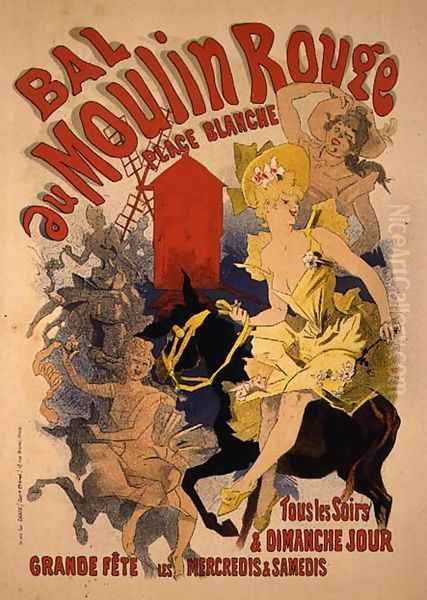
Beyond those directly influenced, Chéret's work garnered admiration from established masters. Impressionists and Post-Impressionists like Claude Monet, Edgar Degas, and Georges Seurat reportedly appreciated his artistry and his ability to capture the vibrancy of modern life. His success helped legitimize the poster as a serious artistic medium, bridging the gap between commercial art and fine art. His circle also included patrons like Eugène Rimmel, who supported his early career and facilitated travels that may have further broadened his artistic horizons. The cross-pollination of ideas between Chéret and these diverse figures highlights his central role in the dynamic Parisian art scene of the late 19th century. His influence extended even to artists like Alphonse Mucha, another giant of Art Nouveau poster design, who built upon the foundations Chéret had laid.
Les Maîtres de l'Affiche (The Masters of the Poster)
Recognizing the growing artistic merit and popularity of the poster, Chéret played a key role in curating and promoting the medium. In 1895, he helped launch Les Maîtres de l'Affiche, a prestigious subscription series published until 1900. This publication reproduced the best posters by leading Parisian artists of the day, albeit in a smaller, collectible format.
Each month, subscribers received four high-quality lithographic reproductions. The series featured works by 97 artists, including Chéret himself, Toulouse-Lautrec, Mucha, Bonnard, Vuillard, Steinlen, Grasset, and many others. Les Maîtres de l'Affiche served not only as a showcase of contemporary graphic art but also helped to solidify the poster's status as a collectible art form. Chéret's involvement underscored his position as a leader and advocate for the medium he had done so much to elevate. The series remains an invaluable historical record of the golden age of the poster.
Art Nouveau Pioneer
While primarily known as a poster artist, Chéret's style was intrinsically linked to the development of Art Nouveau. His emphasis on flowing, organic lines, decorative patterns, dynamic asymmetry, and the integration of text and image were all hallmarks of the burgeoning international style. The "Chérette" herself, with her swirling drapery and energetic poses, can be seen as an embodiment of Art Nouveau's dynamism and decorative flair.
His work predated and ran concurrently with the peak of Art Nouveau, influencing many of its key practitioners in France and beyond. He demonstrated how artistic principles derived from fine art and historical styles like Rococo, combined with influences like Japanese prints, could be adapted for mass communication, paving the way for the widespread application of Art Nouveau aesthetics in graphic design, illustration, and advertising throughout the late 1890s and early 1900s.
Social and Cultural Impact
Chéret's posters did more than just sell products or tickets; they captured and helped define the spirit of an era – the Belle Époque in Paris. His images, plastered across the city, contributed to the perception of Paris as a center of pleasure, entertainment, and modernity. They became part of the fabric of daily life, consumed by Parisians from all walks of life.
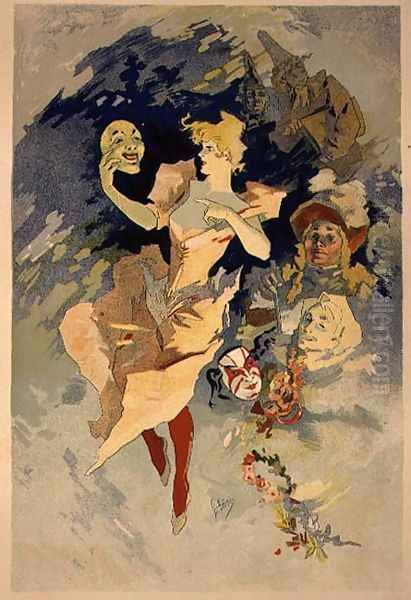
Furthermore, the recurring image of the "Chérette" had a subtle but significant social dimension. At a time when women's roles were undergoing gradual change, Chéret's depiction of active, joyful, and seemingly independent women offered a visual counterpoint to more traditional representations. While created for commercial purposes, these images resonated with contemporary discussions about female emancipation and the "New Woman." His posters visually celebrated a sense of freedom and joie de vivre that became associated with modern femininity, contributing, perhaps unintentionally, to a broader cultural shift in perceptions of women.
Later Life and Enduring Legacy
As the 20th century dawned and artistic styles evolved, Chéret gradually shifted his focus away from posters towards painting, particularly pastels and watercolors, revisiting the Rococo influences of his youth in large decorative schemes. He received significant recognition during his lifetime. In 1890, he was awarded the Légion d'honneur by the French government, an honor upgraded several times throughout his life, culminating in the Grand Cross in 1926.
A major retrospective exhibition of his work was held at the Louvre's Pavillon de Marsan in 1912, cementing his status within the French art establishment. In 1928, the Musée des Beaux-Arts in Nice, the city where he spent his later years, was renamed the Musée Jules Chéret in his honor (now Musée des Beaux-Arts de Nice Jules Chéret), and it houses a significant collection of his works.
Jules Chéret died in Nice on September 23, 1932, at the remarkable age of 96. He was buried in the Cimetière Saint-Vincent in the Montmartre quarter of Paris, a fitting resting place for an artist whose work so vividly captured the spirit of that city. His legacy is immense. He transformed poster design from a minor craft into a major art form, pioneered techniques that revolutionized color printing, and created a visual style that defined an era. His influence is evident in the work of countless graphic designers, illustrators, and advertisers who followed. He remains celebrated as the undisputed "Father of the Modern Poster," whose vibrant creations continue to delight and inspire.
Collections and Recognition
Today, Jules Chéret's works are held in major museums and collections around the world, testament to his enduring importance. The Musée Jules Chéret in Nice holds a primary collection. In Paris, the Musée d'Orsay, the Bibliothèque Nationale de France, and the Musée des Arts Décoratifs (connected to the Louvre complex where his retrospective was held) maintain significant holdings of his posters and prints.

Internationally, his work can be found in institutions such as the Hermitage Museum in St. Petersburg, Russia, and the Museum of Modern Art (MoMA) in New York. Numerous other museums dedicated to decorative arts, graphic design, or late 19th-century art feature his posters. Private collectors also eagerly seek his works, particularly pristine examples of his most famous designs and prints from the Les Maîtres de l'Affiche series. The continued exhibition and study of his work underscore his pivotal role in the evolution of visual communication and modern art.